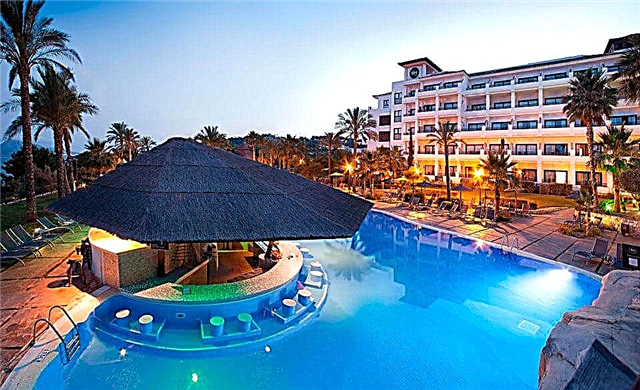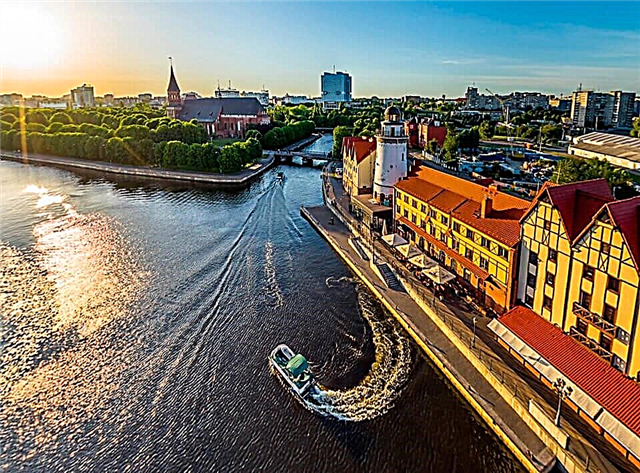Address: Moscow Red Square
Start of construction: 1875 year
Museum opening: 1883 year
Architect: Sherwood Vladimir Osipovich, Semyonov Anatoly Alexandrovich
Coordinates: 55 ° 45'18.7 "N 37 ° 37'03.4" E
Content:
The collections in the country's main historical museum are amazing. For 145 years, it has collected more than 5 million exhibits. The museum contains ancient books, unique artifacts found during excavations in different parts of the country, and many other items that tell about the centuries-old history of Russia.

View of the State Historical Museum from Red Square
Museum history
The massive red brick building of the museum closes the main square of Moscow from the northwest. It is located opposite the picturesque Church of the Intercession of the Mother of God, better known as St. Basil's Cathedral, and is harmoniously combined with the walls and towers of the Moscow Kremlin.
The idea to organize a history museum was born in the middle of the 19th century. In 1872, a major Industrial Exhibition was held in Moscow, which served as the impetus for the creation of two museums - a historical and a polytechnic one. The first exhibits of the historical museum were archaeological exhibits from the exhibition and memorabilia sent by veterans of the Crimean War.
Over the course of several years, so many items had accumulated that Emperor Alexander II ordered the construction of a separate museum building. By his decree, a special commission was created to organize a new museum, the backbone of which was made up of prominent historians V, O. Klyuchevsky, S. M. Soloviev, I. Ye. Zabelin and D. I. Ilovaisky.

Museum entrance
In 1875, a competition of architectural projects was held, in which the work of Anatoly Semyonov and Vladimir Sherwood won. In the same year, the foundation was laid for the future museum building. Materials for construction were brought from different parts of the country, brickwork was fastened with cement, internal partitions were made of metal, and pipes and wires were removed inside the building. 260 bricklayers and over three hundred auxiliary workers worked at the construction site.
The construction of the huge building took 11 years and required significant sums of money. The organizers had to take a bank loan of 1.26 million rubles, and the repayment of this loan took 28 years.
When the work was completed, a massive building in the pseudo-Russian style appeared in the center of Moscow, the eclectic appearance of which perfectly fit into the architecture of Red Square. For the decoration of the museum, kokoshniks, arcature belts, fly belts, weights, tents and other elements of traditional ancient Russian architecture were used.

The museum was opened in 1883. By that time, the building had not yet been fully decorated, so it was decided not to arrange lavish ceremonies. The first visitors to see the 11 finished rooms were Emperor Alexander III and his wife. A few days later, the new museum was consecrated and opened to the general public.
After the revolutionary events of 1917, the museum was repeatedly wanted to close, but this did not happen. Over the 10 years of Soviet power, museum funds have doubled, mainly due to the fact that valuables from former noble estates were brought here.
During the war years, the most valuable part of the collections was evacuated to Kazakhstan. It is noteworthy that even during the siege of the capital, the historical museum was not closed and received visitors, remaining the only working museum in Moscow. Only in the fall of 1941 it was closed for one week in order to liquidate the consequences of the destruction that occurred during the bombing.
By the 1980s, technical problems began in the history museum. For 100 years, the building has never been repaired and therefore it is badly dilapidated. The major reconstruction of the museum was carried out from 1986 to 2002.

Exposure
The treasures collected in the museum are displayed in 39 rooms. However, on an area of 4000 sq. m managed to accommodate only 22 thousand exhibits. This is only a small part of the items stored in the historical museum - 0.5% of the available funds. All exhibits of the State Historical Museum cannot be viewed during one visit. If you linger at each display case for just one minute, it will take 360 hours to fully explore the collection! It is not surprising that more than 800 employees work to service such a huge museum.
The Historical Museum is considered the largest national museum in the country, and is visited by up to 1.2 million people annually. In order for tourists to see rare artifacts stored in storerooms, exhibitions are organized here all year round.
Walking through the halls of the museum, visitors can learn about the history of the country, from ancient times to the beginning of the last century. Recently, the main exhibitions can be viewed virtually. To do this, just go to the museum website.

Interiors
The architects paid great attention to the design of the museum's interiors. All rooms are a circular enfilade, and valuable materials were used for their decoration - Carrara marble and oak panels, stucco and gilding.
The most richly decorated rooms occupy the first floor of the museum building. The windows have unique bindings imitating ancient mica windows, the halls are closed with pine and oak doors, and the floors are decorated with picturesque mosaics. Wall and ceiling paintings in the museum were made by talented Russian artists - Ilya Repin, Viktor Vasnetsov, Ivan Aivazovsky and Valentin Serov.
First, visitors enter the Main Hall, decorated with the family tree of the Russian emperors. On the skillfully made wall paintings one can see the life-size portraits of princes and tsars - from Prince Vladimir to Alexander III.
The halls on the first floor tell about Russian history, from the primitive system to the era of the reign of Peter I. In the letter halls "A", "B" and "C" unique gold items of different times and peoples are exhibited - jewelry, nuggets, objects of church art, orders and weapons.

On the second floor of the museum building there are exhibits that tell about the history of the country from the times of Peter the Great to the end of the 19th century. The entrance to the reading room of manuscripts is also located here.
The most unique exhibits
The huge collection of the Historical Museum contains rare books. The most valuable of them are considered "Izbornik Svyatoslav", which appeared in 1073. It consists of correspondences of Bulgarian texts, which were made by order of the son of Yaroslav the Wise - Prince Svyatoslav.
In addition, the museum stores the first Russian printed book "Apostle", published by Ivan Fedorov in 1564. The rare book is adorned with leather binding and exquisite gilded embossing. It is noteworthy that for the "Apostle" the first printer used paper made in France.
In the halls of the museum you can see the state seal of the sovereigns Ivan and Peter Romanov and the top of their father's fur coat, Tsar Alexei Mikhailovich. The rich royal fur coat is insulated with squirrel fur and trimmed with expensive satin fabric.

In one of the halls, a letter on a walrus tusk is exhibited, written at the end of the 18th century during an expedition organized by the decree of Catherine II. The most valuable exhibits also include the award-winning saber of Napoleon and the large outdoor globe of the 17th century, brought to Russia by Peter I.
Information for visitors
The exits located on the side of Red Square are closed, so tourists who come to look at the mausoleum, Execution ground, the Kremlin towers or the Intercession Cathedral rarely visit the museum. The Historical Museum is often visited by groups of schoolchildren and those who want to visit thematic exhibitions.
At the entrance, tourists can receive a complete map of the exposition or download it on the museum's website. This innovation greatly simplifies the navigation through the halls.
The museum is open all days, except Tuesday, from 10.00 to 18.00, and on Saturdays and Sundays - until 21.00.From June to September, it works seven days a week. Please note that ticket offices close 45 minutes before the museum closes.

Tickets for adults cost 400 rubles, for students and pensioners - 150 rubles. Admission is free for children under 16. For a family visit (two adults and 1-2 children), you can purchase a discount ticket worth 600 rubles (2018) to enter the museum.
How to get there
The Historical Museum has a symbolic address - Red Square, house No. 1. The museum building is easily accessible on foot from the Moscow metro stations Okhotny Ryad or Teatralnaya. A little more time will take a pedestrian walk from the "Revolution Square" or "Library of them. Lenin ".











